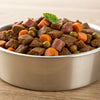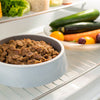How Much Wet Dog Food for a 10 Pound Dog: A Comprehensive Guide
- Houndsy
Table of Contents
- Introduction
- Understanding Your Dog's Nutritional Needs
- Wet Dog Food Feeding Guidelines
- The Benefits of Wet Dog Food
- Our Approach at Houndsy
- Adjusting Feeding Based on Life Stages and Health Needs
- Conclusion
Introduction
Did you know that nearly 60% of dogs in the United States are classified as overweight or obese? This sobering statistic underscores the critical importance of understanding our pets' dietary needs, especially when it comes to portion sizes. For those of us who cherish our canine companions, one burning question often arises: "How much wet dog food should I feed my 10-pound dog?"
Proper feeding goes beyond just filling a bowl; it involves knowing how to balance calories, nutrients, and dietary requirements to ensure our furry friends lead healthy lives. In this blog post, we will explore the nutritional aspects, general feeding guidelines, and practical strategies for determining the right amount of wet food for our beloved pets. By the end of this article, you will possess a clear understanding of how much wet dog food is appropriate for a 10-pound dog, along with helpful tips that can further enrich your feeding experience.
At Houndsy, we believe in elevating the dog-feeding ritual, making it not just a necessity but a joyful experience. So let’s dive in and reflect on your own feeding routines while we unravel the secrets to perfect portions.
Understanding Your Dog's Nutritional Needs
Feeding your dog the right amount of food is crucial not just for their physical appearance but also for their overall health and vitality. Here are the key factors you should consider when determining how much wet dog food to provide your 10-pound pooch:
1. Dog’s Weight
The most straightforward factor impacting how much your dog eats is their weight. Generally, for dogs weighing around 10 pounds, the recommendations typically suggest 3 to 4 ounces of wet food per day, but this can vary based on the specific brand and formulation of the food.
2. Activity Level
A dog's energy expenditure is directly related to how much food they require. Active and energetic dogs need more calories than those who prefer lounging around. If your 10-pound dog runs around actively every day, they might need a bit more food than a more sedentary pup of the same weight.
3. Age and Life Stage
Puppies, adults, and senior dogs all have different dietary requirements. Puppies, for instance, require more food relative to their weight due to their rapid growth and development. On the other hand, senior dogs may need less food as their metabolism slows down. It is critical to adjust the daily intake based on your dog’s respective life stage.
4. Health Status
Health issues can significantly impact your dog's nutritional needs. For instance, dogs with diabetes often have strict dietary needs, while those with kidney concerns may require diets lower in protein. Always consult your veterinarian for advice tailored to your dog’s unique health conditions.
Wet Dog Food Feeding Guidelines
Now that we have an understanding of your dog’s nutritional needs, let’s explore some general feeding guidelines provided by wet dog food manufacturers, using a 10-pound dog as our primary example.
General Feeding Recommendations
Most wet dog food labels will contain feeding recommendations based on your dog's weight. Here’s a simplified overview:
- Small Dogs (up to 20 lbs): 3 oz of wet food per 3-4 lbs of body weight daily.
- For a 10-pound dog, this translates to approximately 7 to 10 ounces of wet food per day.
Example Calculation
Let's delve deeper into an example. Suppose you are using a standard 12.5 oz can of wet food. The guidelines suggest:
- 10 to 15 lbs → feed one can per day.
Since your dog weighs 10 lbs, you can feed approximately half of the can, split into two meals throughout the day to ensure your dog receives adequate nourishment.
Adjusting Portions
It’s important to monitor your dog’s weight regularly and adjust their feeding portions if necessary. If your dog is gaining weight, you may want to consider cutting back a bit on their portions or consulting with your veterinarian for a tailored plan.
The Benefits of Wet Dog Food
Incorporating wet dog food into your pet's diet provides a plethora of benefits, particularly for dogs. Here are a few reasons why wet food can be a fantastic option:
1. Hydration
Wet food contains higher moisture content compared to dry kibble, which aids in hydration. This is particularly useful in warmer temperatures or if your dog doesn’t drink as much water as they should.
2. Palatability
Many dogs find wet food more enticing than dry food due to its aroma and texture. If you have a picky eater, switching to wet food—or mixing it with dry—can make mealtimes more appetizing.
3. Nutritional Variety
Wet foods often come packed with rich nutritional profiles, providing dogs with essential vitamins and minerals. Mixing different flavors and varieties can also enhance your dog's diet, ensuring they get a broad spectrum of nutrients.
4. Convenience
Wet food is easy to serve and store, saving busy pet owners time during mealtimes. No more pouring and measuring; a quick scoop can be all it takes to keep your dog happy.
Our Approach at Houndsy
At Houndsy, we are passionate about creating innovative solutions that simplify the dog-feeding experience while still keeping it beautiful and stylish. That’s why we developed the Houndsy Kibble Dispenser—a product designed to address common feeding challenges while also enhancing your home decor.
Features of the Houndsy Kibble Dispenser
-
Convenient Crank: The unique crank feature allows you to dispense the perfect portion easily, standing up straight without the achy back from bending over.
-
Beautiful Design: Our dispenser combines mid-century modern aesthetics with practical functionality, seamlessly blending into your home.
-
Large Storage Capacity: With a capacity of 25-30 lbs, you'll spend less time refilling and more time enjoying the moments that matter.
-
BPA-Free Liner: Our dispenser includes a BPA-free liner that keeps food fresh and safe for your beloved dog.
-
Auto-Locking Mechanism: Designed to prevent curious pets or toddlers from making a mess, ensuring feeding time stays clean and efficient.
Discover how the Houndsy Kibble Dispenser can enhance your dog-feeding experience by visiting our product page.
Adjusting Feeding Based on Life Stages and Health Needs
As dogs transition through different life stages, their dietary needs change. This section breaks down how to adjust feeding based on age and health status:
Puppies
Puppies require significantly more calories and nutrients than adult dogs. For instance, a puppy may need up to twice the amount of wet food per pound of body weight in comparison to an adult. Be sure to consult with your veterinarian for specific feeding guidelines tailored to your puppy’s breed and size.
Adult Dogs
For adult dogs, a consistent routine is essential. Active dogs might require higher food intake to match their energy, while less active dogs should stick to lower calorie requirements. Monitoring weight and adjusting portions is crucial for maintaining a healthy body condition.
Senior Dogs
For senior dogs, decreased activity levels may warrant a lower calorie intake. Ensure you’re feeding a wet food formulated for senior dogs that is often lower in calories while still providing the nutrients necessary for their health. Look for wet food containing glucosamine and other joint-supportive nutrients.
Conclusion
Determining how much wet dog food is appropriate for your 10-pound dog involves considering various factors including weight, activity levels, age, and health status. By understanding these elements and following the general feeding guidelines, we can ensure our furry companions receive the right nutrition to thrive.
As responsible pet parents, we want to create a joyful feeding experience, while also recognizing the significance of portion control in our dog's diet. At Houndsy, we aim to enhance the daily feeding ritual through design excellence and functionality.
Now that you have all the tools to optimize your dog's feeding routine, consider how our innovative Houndsy Kibble Dispenser can further elevate this experience. Visit Houndsy to learn more!
Frequently Asked Questions
-
How do I determine the right amount of wet dog food for my dog? Begin by checking the feeding guidelines on your dog's food label based on their weight. This information serves as a useful starting point. Also, consult your veterinarian to personalize your dog's feeding plan.
-
Can I mix wet dog food with dry food? Yes! Mixing wet and dry dog food can offer added flavor and moisture. Just remember to adjust the overall quantity you feed to avoid overfeeding.
-
How often should I feed my dog wet food? Most adult dogs thrive on two meals per day, while puppies may require three to four meals depending on their size and breed.
-
Is the Houndsy Kibble Dispenser suitable for wet dog food? While primarily designed for dry food, the Houndsy Kibble Dispenser can certainly store wet food as long as it's kept in the appropriate container to maintain freshness.
-
What should I do if my dog is overweight? If your dog is overweight, consult your veterinarian for tailored dietary recommendations. You may need to adjust their food intake and introduce a regular exercise routine.
By following these guidelines and utilizing the Houndsy Kibble Dispenser, we can elevate our feeding experiences, ensuring our furry friends remain healthy, happy, and well-nourished.













